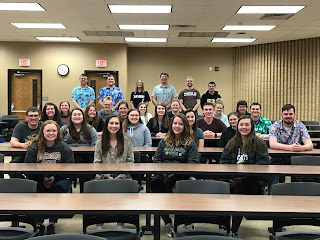Editor's note: This post is missing a few of the intended pictures. Those missing pictures will be added when the class has better access to the Internet.
2nd Editor's note: The missing pictures have been added . 21May2019 8:40am Brookings time.
 |
| A Friesian bull that is near the 18
month of age and will be sent to slaughter soon. |
 |
| The group listening to Peter talk about the bull beef
operation. |
We started the day off by visiting
Peter and Adrienne Borrie dairy farm where they have dairy cows and bull beef.
Their operation consists of 1,711 hectares and they lease 60 hectares of grass
that they use to winter livestock. The breakdown of the 1,711 hectares consists
of 400 hectares all irrigated, 800 hectares that they are developing irrigation
on, and the rest of the hectares are used for dairy buildings and pastures.
Their main source of irrigation has been converted to spray irrigation, where
they get water from the Wakiki River, so they do not have to pay for the water.
We first saw their bull beef operation, where a majority of their income is
made in the dairy part of their production. They have 850 bull calves on the
property, where 60-70% of them stay on the property for 18 months before they
are sent to slaughter. They weigh 550- 600 kg live weight and typically dress
between 56- 58% and have a 260- 270 kg hang weight, which they get $5/ kg for
the 18 month bulls. The other 30- 40% of bulls are kept another winter and sold
to dairy farms as clean up bulls. They also have around 250 steers and heifers,
which generally do not have as high as expectations and are calves from the
Hereford bull, so they do better as steers. Any other calves are sold as bobby
calves.
This dairy is almost a
completely closed herd, but they do purchase fifty Hereford bulls from another
closed herd operation for clean up bulls. They run majority Frisian cows with
Jersey and Kiwi crosses. Peter and Adrienne have a son, Rogan, who has
purchased all of their original land and is expanding.
 |
| We visited Springdale Farming Co. to see their cropping
operation. |
We then
stopped at Springdale Farming Co. to visit their cropping farm. They moved here
in 2001 from England and grow wheat, barley, white clover seed, canola, kale,
carrots, and Lily bulbs. They have 1200 acres of irrigated land, cultivate 1100
acres for their neighbors, and do custom harvesting and baling for several
farmers. They are able to pull 80 liters/ second out of a 200 meter well and
the recharge is very quick due to the water runoff from the Southern Alps.
Although they do not have to pay for water in their spray irrigation systems,
they make up for that with having to pay $30,000/ month for electricity to pump
the water through the pivots. A solar panel system also helps them track the
soil moisture levels, which they ideally want at 25%.
 |
| A typical spray irrigation system
that would be found on a cropping farm, which can be 680 meters long. |
 |
| We got to see Springdale’s variety of tractors and
equipment. |
 |
| A mob of heifers that are being grazed on kale and
barley straw for the winter. |
Along with farming, they also
winter a fair amount of dairy cattle, beef cattle, and sheep. They feed the
dairy cattle brassica and barley straw that equal 13 kg of dry matter/ day.
They also graze hoggets, young ewes, ryegrass throughout the winter months. The
beef cattle are fed 17 meters of kale per day, where they use adjustable fence
to control their intake. They make a reasonably good income from wintering
livestock, where they make $17/ cow/ week and $2/ sheep/ week. Another source
of income is selling their excess straw to dairy producers and silage to other
beef producers who are struggling with M. Bovis. The family came here looking
for a better opportunity and it has definitely paid off in more ways than one.
 |
| A kale field with a solar panel that is used to help
measure the soil moisture. |
 |
| A field of lily bulbs that produce a large income,
which will be sold to Japan. |
 |
| A vital piece of equipment that is used for their
custom bailing business. | |
 |
| The group enjoys the last meal we will have together in
New Zealand. |
We concluded the day by traveling
to Christchurch where we got to view the city and have supper together one last
time before we depart for home.
Jonalyn and Denver













what A farm love to visit this place
ReplyDeletesuficheap